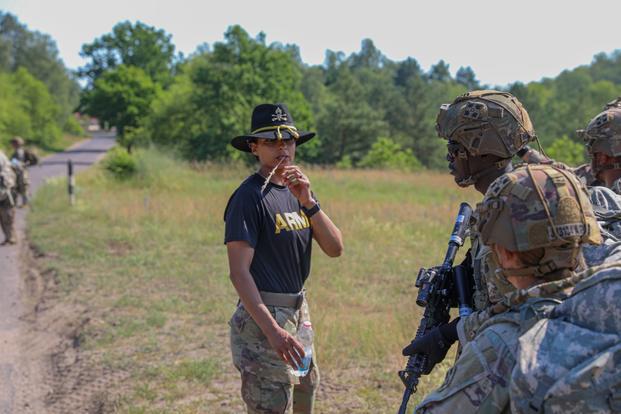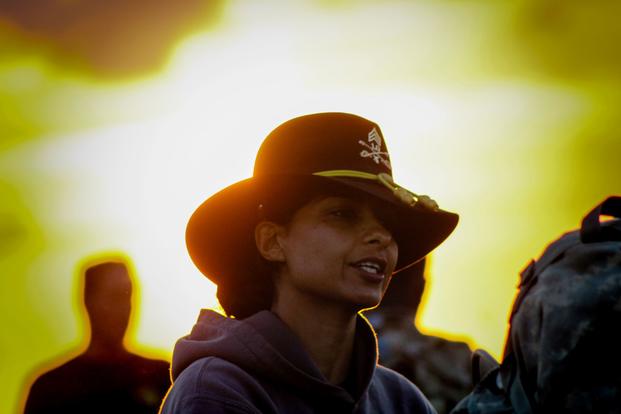U.S. Army Staff Sgt. Zahraa Frelund first encountered American troops when she was escaping Iraqi soldiers who had assaulted her in Baghdad, having left her hometown of Babylon as a 19-year-old in 2009 seeking a job as an interpreter with the occupying U.S. force.
Running barefoot as the soldiers fired their AK-47s in her direction, troops from the same army in which her father had been an officer during the Saddam years, she bumped into a group of Americans dressed in civilian clothing. They scooped her up into a car and took her to safety just outside of Camp Liberty, a sprawling headquarters for American forces in the country.
The next day, Frelund found herself in the highest risk of job interviews. She begged an American Army captain from the 1st Cavalry Division to give her a job and not force her to go back out to town, where she was sure she would be killed or sold into the sex trafficking underworld where so many Iraqi women had disappeared.
Read Next: Army Private's Death and Claims of Harassment Again Shine Spotlight on Fort Hood
"You send me outside the base. No shoes, no clothes, no cover. I'm screwed. I'm definitely getting killed," Frelund said. "He took me to the PX barefoot ... people looking. He bought me shoes and hygiene things. He got me a room; I remember I felt safe. And at that moment with a cold shower, it hit me. ... That's one of these moments I reflect on feeling so good. I felt safe. Now, I feel no one can touch me. No one's gonna kill me."
She was hired and would eventually find her way from Baghdad to Utah, where she studied material design and worked as a project manager in Salt Lake City before wanting something more adventurous. Ten years after making it to America, she would join the service she credits with saving her life.
Now, stationed in South Korea as a cavalry scout, she is in an extreme minority of women serving in combat arms in the U.S. military, a specialty made available to women less than a decade ago. In total, some 2,200 active-duty women out of roughly 40,000 are serving in infantry, cavalry, armor and field artillery roles, according to data provided by the service. Only 114 women have graduated Ranger School, largely seen as a critical school for ground combat leaders.
Frelund is a model soldier, especially excelling in physical fitness. She won a deadlift competition in January, wrangling 320 pounds despite her slight frame. She was also a top competitor in last year's Soldier of the Year competition.
The very same war that would spur decades of chaos in the country of her birth also radically changed the American military to which she would one day pledge her life. It would create more educational and career opportunities for Iraqi women, while forcing others to flee for safety. But it also left its imprint on the occupying force. The trail Frelund now blazes was mapped by women who fought in Iraq at a time when American policymakers were still queasy about the prospect of women in combat.
More than 100 American women would die as part of Operation Iraqi Freedom, the largest loss of uniformed women since World War II, a campaign that began 20 years ago this week with air operations commencing March 20, 2003. Those casualties happened despite the fact that women were still excluded from combat jobs until after the U.S. withdrawal in 2011.
A Reagan-era requirement, known as the "Risk Rule," had kept women from jobs where it was thought they were more likely to be killed. That policy was eliminated by President Bill Clinton in 1994 and, while women were still precluded from directly serving in ground combat units, the dividing lines intended to keep women from harm's way, and from a range of careers, got blurred in the mayhem of the Iraq campaign.
"Visibility-wise, apparently, the higher-ranking men didn't know what was going on," Lt. Col. Denise Little, recalling her service as a platoon leader from 2004 to 2005 in Iraq, told the West Point Center for Oral History a decade ago. The group records extensive interviews with graduates detailing their military careers and war stories.
Little had been leading a convoy in 2004 when she spotted a car with its trunk ajar speeding toward her troops. It pulled up short and fired off a mortar. She jumped from her vehicle and, with gear weighing as much as a small child on her back, sprinted toward the attackers.
"Vengeance is mine, so sayeth the Lord, but subcontract it to me," she recalled thinking.
She paused to take a three-point stance before firing two rounds into the kneecaps of one of the assailants as three men attempted to flee. The man dropped to the ground, and the other two stopped and put their hands up.
Like many women, she encountered an environment with few others of her sex around and commanders who seemed to be unaware of the changing face of the force. She was called in after a commander heard a tale of a woman taking command during a night patrol that was apt to turn hairy.
"He knew he had females, but he thought they were medics or manning the radio," Little said. "He didn't realize we were doing the same ambushes and route security and quick reaction force."
The broader realization that women were already facing the dangers of war spurred by the mounting casualty counts helped drive a new policy discussion that led to the removal of barriers announced by then-Defense Secretary Leon Panetta in 2013 and taking effect in the following years. America had been waging two wars, but more than twice as many women died in the Iraq campaign as in Afghanistan, partly a reflection of the different styles of combat.
The policy, which would take effect over the next couple of years across the military services, meant that the artificial distinction between combat and non-combat jobs would no longer hinder women. And soldiers like Frelund would have new opportunities.
But women are still not fully accepted into combat arms as the culture of ground combat units has been slow to evolve, multiple women in those fields have told Military.com. The issues mostly stem from skepticism that women can do the physically demanding work, while some men seek to preserve long-cherished boys' clubs.
Some men described perceiving the need to walk on eggshells, afraid of basking in the gallows humor that is a staple of front-line unit banter. Commanders are at times still unsure of whether they should have men and women share tents during field training.
Progress has come nonetheless, with women taking up a growing number of positions in a growing number of fields and positions of authority. And even before the combat job barrier was removed, their very presence in Iraq served as a model for the women of the country.

Little, a West Point graduate who is now a student at the U.S. Naval War College, described her favorite day during her tour as occurring in early 2005 when Iraqi women went to the polls for the first time. She was approached by women who ran up to her, recognizing that she was a rare woman in uniform. They would wave their ink-stained fingers, a rudimentary tracking system to prevent Iraqis from voting twice, in her face celebrating their opportunity to participate in their own government.
Although troops like Little did model a different societal role, Iraqi women have faced extreme violence in wake of the U.S. invasion and remain bound by deeply ingrained cultural views about the role of women.
Frelund left home because of frequent beatings from her parents tied to cultural constraints in the religiously conservative country.
After her mother slapped her in public over a disagreement over what shoes would best match Frelund's traditional Muslim garb that covered virtually all of her body, she left her family and college, hoping to work for Americans.
While most Iraqi refugees fled as families, conflict inside households is all too common, said Merissa Khurma, the director of the Middle East Program at the Wilson Center think tank in Washington, D.C.
"You're not supposed to talk about what happens in the home," Khurma said. "If you break that barrier, it says a lot about the wills not just to survive, but to do more than that."
With the U.S. military invaders seen as an external threat, Iraqis turned insular and more patriarchal, which in turn led to more violence against women, she said. It's a problem with which the country continues to struggle, with the United Nations estimating last year that nearly a million Iraqi women and girls were at risk for gender-based violence.
Violence outside of the home during the instability brought on by the U.S. invasion has also claimed many lives. While the exact number of civilian casualties is not known, Brown University's Cost of War Project estimates up to 210,000 Iraqi civilians have been killed since March 2003.
"In most war scenarios, women are usually the ones that pay the price for what is happening around them, and that is something that absolutely happened in Iraq," Khurma said. "And of course, since the Iraq War in 2003, Iraq has been through so many iterations of violent cycles, including ISIS. And with that, we've also seen a whole other dimension of subjugation of women, of violence, rape. And these communities are still suffering the consequences."
In public life, Iraqi women have made some progress since the invasion, such as provisions in the constitution adopted following the 2005 election that bar discrimination based on gender and set a quota of 25% for women in parliament. But for every step forward Iraqi women take, they face resistance, Khurma said.
"Implementation requires changes in mindsets and social and cultural norms," she said. "I was just in Iraq and had an opportunity to chat with a few women rights activists. And they said that there's a lot of pushback. Every time they take a few steps forward, there is pushback. And a lot of the times, it comes from the more sort of traditional old guard groups or from Islamist groups."
For Frelund, life in the United States, and in the Army, has provided new opportunities she's seizing.
When she showed up to basic training, she saw one of her drill sergeants wearing a 1st Cavalry Division patch, the same worn by the captain whom she credits with saving her life a decade ago when she was fleeing Iraqi soldiers who had assaulted her. "I'm like, 'holy s--t.' It was the 1st Cavalry, who literally saved me in Iraq. Because all I remember, all I remember is the horse [on the patch]."
She was in one of the first basic training classes for scouts with women in the ranks in 2019. Out of 24 of them, only 12 graduated, according to Frelund -- and even fewer eventually become noncommissioned officers.
"It's hard for a female to be a scout. You hear all the comments, all negative, and I do my best to be positive. All I can do to earn that respect is perform, so for PT, I kill it. If there's a competition I'm first to volunteer."
Editor's note: After her interview with Military.com, Frelund was promoted to staff sergeant. This story has been updated to reflect her new rank.
-- Steve Beynon can be reached at Steve.Beynon@military.com. Follow him on Twitter @StevenBeynon.
-- Rebecca Kheel can be reached at rebecca.kheel@military.com. Follow her on Twitter @reporterkheel.
Related: The First Casualty of War Is Truth: Iraq 20 Years Later














